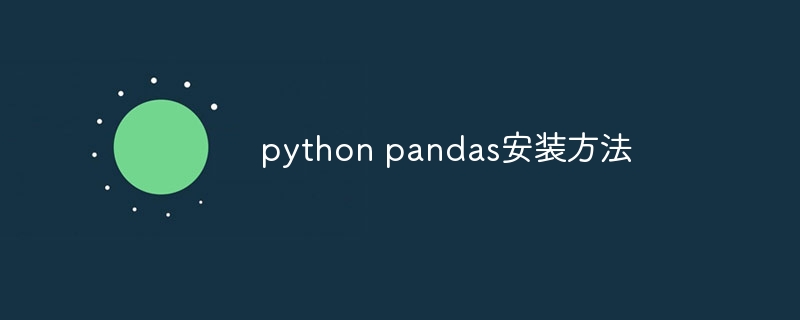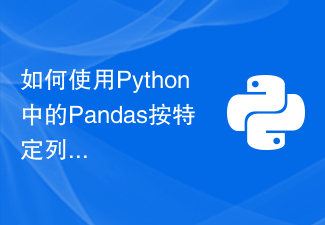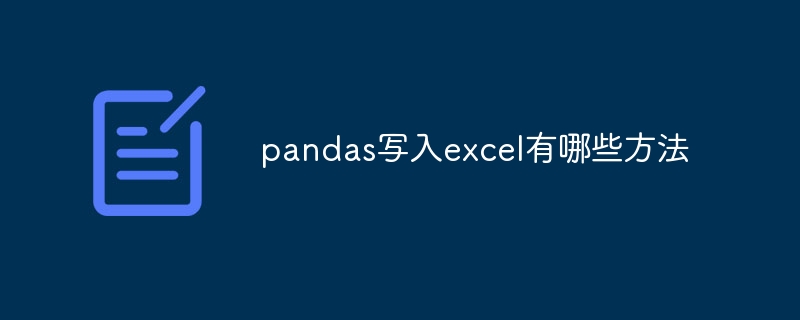
Practical tips for using Pandas for data filtering
Pandas is a powerful data processing library that is widely used in data analysis and data science. Data filtering is a common task during data processing. This article will introduce how to use Pandas for data filtering and provide specific code examples.
1. Filter data based on conditions
- Use conditional operators to filter
Pandas provides a variety of conditional operators to filter data based on conditions. . Commonly used operators include equal (==), not equal (!=), greater than (>), less than (=), less than or equal to (
For example, assuming there is a DataFrame object df, which contains the student's name (name), age (age) and score (score), we can use the following code to filter out student data with scores greater than or equal to 90 points :
df_filtered = df[df['score'] >= 90]
- Filtering using multiple conditions
In addition to a single condition, Pandas also supports using multiple conditions for data filtering. Conditions can be combined using the logical operators and, or and not.
For example, suppose we want to filter out the data of students who are between 18 and 25 years old and whose scores are greater than or equal to 80 points. You can use the following code:
df_filtered = df[(df['age'] >= 18) & (df['age'] <= 25) & (df['score'] >= 80)]
2. Filter data based on index
The DataFrame object in Pandas automatically generates an integer index by default, and you can use the index to filter data.
- Filtering using positional index
You can use the iloc attribute to filter data based on the positional index of rows and columns.
For example, assuming we want to filter out the data from rows 2 to 5, we can use the following code:
df_filtered = df.iloc[2:6, :]
- Use tag index to filter
If the label index is set in the DataFrame object, you can use the loc attribute to filter the data based on the label index.
For example, assuming we want to filter out student data that is 20 years or older, we can use the following code:
df_filtered = df.loc[df['age'] >= 20, :]
3. Filter data based on fields
In addition to using conditions and Filter by index, and you can also filter data based on fields.
- Filter data based on column names
You can use column names to filter out specified column data.
For example, assuming we only want to filter out data in the two columns of name and grades, you can use the following code:
df_filtered = df[['name', 'score']]
- Filter data based on field values
You can use the value of the field to filter out the data corresponding to the field value.
For example, suppose we want to filter out student data with scores between 80 and 90 points, you can use the following code:
df_filtered = df[df['score'].between(80, 90)]
The above are practical techniques for using Pandas for data filtering, through flexible Using conditions, indexes and fields, you can easily filter out the data you need. I hope this article will help you in your data processing process!
The above is the detailed content of Practical tips and examples of Pandas data filtering. For more information, please follow other related articles on the PHP Chinese website!
 python pandas安装方法Nov 22, 2023 pm 02:33 PM
python pandas安装方法Nov 22, 2023 pm 02:33 PMpython可以通过使用pip、使用conda、从源代码、使用IDE集成的包管理工具来安装pandas。详细介绍:1、使用pip,在终端或命令提示符中运行pip install pandas命令即可安装pandas;2、使用conda,在终端或命令提示符中运行conda install pandas命令即可安装pandas;3、从源代码安装等等。
 日常工作中,Python+Pandas是否能代替Excel+VBA?May 04, 2023 am 11:37 AM
日常工作中,Python+Pandas是否能代替Excel+VBA?May 04, 2023 am 11:37 AM知乎上有个热门提问,日常工作中Python+Pandas是否能代替Excel+VBA?我的建议是,两者是互补关系,不存在谁替代谁。复杂数据分析挖掘用Python+Pandas,日常简单数据处理用Excel+VBA。从数据处理分析能力来看,Python+Pandas肯定是能取代Excel+VBA的,而且要远远比后者强大。但从便利性、传播性、市场认可度来看,Excel+VBA在职场工作上还是无法取代的。因为Excel符合绝大多数人的使用习惯,使用成本更低。就像Photoshop能修出更专业的照片,为
 如何使用Python中的Pandas按特定列合并两个CSV文件?Sep 08, 2023 pm 02:01 PM
如何使用Python中的Pandas按特定列合并两个CSV文件?Sep 08, 2023 pm 02:01 PMCSV(逗号分隔值)文件广泛用于以简单格式存储和交换数据。在许多数据处理任务中,需要基于特定列合并两个或多个CSV文件。幸运的是,这可以使用Python中的Pandas库轻松实现。在本文中,我们将学习如何使用Python中的Pandas按特定列合并两个CSV文件。什么是Pandas库?Pandas是一个用于Python信息控制和检查的开源库。它提供了用于处理结构化数据(例如表格、时间序列和多维数据)以及高性能数据结构的工具。Pandas广泛应用于金融、数据科学、机器学习和其他需要数据操作的领域。
 时间序列特征提取的Python和Pandas代码示例Apr 12, 2023 pm 05:43 PM
时间序列特征提取的Python和Pandas代码示例Apr 12, 2023 pm 05:43 PM使用Pandas和Python从时间序列数据中提取有意义的特征,包括移动平均,自相关和傅里叶变换。前言时间序列分析是理解和预测各个行业(如金融、经济、医疗保健等)趋势的强大工具。特征提取是这一过程中的关键步骤,它涉及将原始数据转换为有意义的特征,可用于训练模型进行预测和分析。在本文中,我们将探索使用Python和Pandas的时间序列特征提取技术。在深入研究特征提取之前,让我们简要回顾一下时间序列数据。时间序列数据是按时间顺序索引的数据点序列。时间序列数据的例子包括股票价格、温度测量和交通数据。
 pandas写入excel有哪些方法Nov 22, 2023 am 11:46 AM
pandas写入excel有哪些方法Nov 22, 2023 am 11:46 AMpandas写入excel的方法有:1、安装所需的库;2、读取数据集;3、写入Excel文件;4、指定工作表名称;5、格式化输出;6、自定义样式。Pandas是一个流行的Python数据分析库,提供了许多强大的数据清洗和分析功能,要将Pandas数据写入Excel文件,可以使用Pandas提供的“to_excel()”方法。
 pandas如何读取txt文件Nov 21, 2023 pm 03:54 PM
pandas如何读取txt文件Nov 21, 2023 pm 03:54 PMpandas读取txt文件的步骤:1、安装Pandas库;2、使用“read_csv”函数读取txt文件,并指定文件路径和文件分隔符;3、Pandas将数据读取为一个名为DataFrame的对象;4、如果第一行包含列名,则可以通过将header参数设置为0来指定,如果没有,则设置为None;5、如果txt文件中包含缺失值或空值,可以使用“na_values”指定这些缺失值。
 pandas怎么读取csv文件Dec 01, 2023 pm 04:18 PM
pandas怎么读取csv文件Dec 01, 2023 pm 04:18 PM读取CSV文件的方法有使用read_csv()函数、指定分隔符、指定列名、跳过行、缺失值处理、自定义数据类型等。详细介绍:1、read_csv()函数是Pandas中最常用的读取CSV文件的方法。它可以从本地文件系统或远程URL加载CSV数据,并返回一个DataFrame对象;2、指定分隔符,默认情况下,read_csv()函数将使用逗号作为CSV文件的分隔符等等。
 4000字详细说明,推荐20个好用到爆的Pandas函数方法Aug 10, 2023 pm 02:52 PM
4000字详细说明,推荐20个好用到爆的Pandas函数方法Aug 10, 2023 pm 02:52 PM今天分享几个不为人知的pandas函数,大家可能平时看到的不多,但是使用起来倒是非常的方便,也能够帮助我们数据分析人员大幅度地提高工作效率,同时也希望大家看完之后能够有所收获。


Hot AI Tools

Undresser.AI Undress
AI-powered app for creating realistic nude photos

AI Clothes Remover
Online AI tool for removing clothes from photos.

Undress AI Tool
Undress images for free

Clothoff.io
AI clothes remover

AI Hentai Generator
Generate AI Hentai for free.

Hot Article

Hot Tools

SAP NetWeaver Server Adapter for Eclipse
Integrate Eclipse with SAP NetWeaver application server.

Dreamweaver Mac version
Visual web development tools

ZendStudio 13.5.1 Mac
Powerful PHP integrated development environment

Atom editor mac version download
The most popular open source editor

SublimeText3 Linux new version
SublimeText3 Linux latest version






